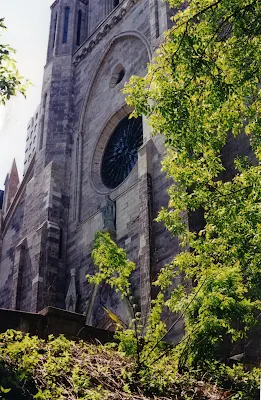When I visited Luke Callaghan Memorial School in the fall of 1998 it had already been closed as a school; the building is just a block from St. Michael's Church. At the time I visited it was the location of various art and public service organizations. It had been an English-language school in the Catholic School Board of Montreal; it closed (like many other English-language schools in Montreal) due to a decline in student numbers caused by the Quebec government, the children of immigrants had to enroll in the French sector schools. Luke Callaghan was the priest who oversaw the building of St. Michael's Church and then he was the pastor at the church until his death in 1931. Luke Callaghan is my great, great uncle. There is more on him and his two brother on other pages of this blog, or click on www.morrisseyfamilyhistory.com.
 |
Luke Callaghan Memorial School in 2009
|
 |
| Luke Callaghan Memorial School in 1927 |
%20at%20Luke%20Callaghan%20Memorial%20High%20School,%201.jpg) |
Graduating class from Luke Callaghan Memorial School, 1930s, copied from Facebook
|
%20at%20Luke%20Callaghan%20Memorial%20High%20School,%202.jpg) |
Graduating class from Luke Callaghan Memorial School, 1930s, copied from Facebook
Below: that's St. Michael's Church (on St. Viateur West), just a block away on Clarke Street, as seen from the Luke Callaghan Memorial School.
|
.jpg) |
| View of St. Michael's Church from Luke Callaghan Memorial School |
.jpg) |
Possibly Clarke Street, near Luke Callaghan Memorial Church
|
.jpg) |
Luke Callaghan Memorial School
|
 |
| Luke Callaghan Memorial School |
.jpg) |
| Luke Callaghan Memorial School |
The following, from http://memoire.mile-end.qc.ca/fr/ecole-luke-callaghan/ website, is of interest:
Luke Callaghan School, originally named St. Michael's, was the school for the Irish Catholic community in Mile End. Opened in 1907, it was initially located on rue Boucher, at the corner of rue Drolet. The Sisters of Saint Anne teach the girls and the Marist Brothers, the boys.
After the construction in 1915 of the new St. Michael 's Church at its current location, rue Saint-Viateur Ouest, the school moved in turn. Classes were first held in rented stores on rue Saint-Viateur until the opening in 1922 of the current building, located on rue Clark, between Saint-Viateur and Bernard. The Sisters of Saint Anne still teach girls there, who use a separate entrance. After the withdrawal of the Marist Brothers in June 1925, the parish priest, Luke Callaghan, entrusted the teaching of the boys to a community from Ireland, the Presentation Brothers. The school was renamed Luke Callaghan Memorial after the priest's death in 1931.
The departure of the Irish population from Mile End during the 1950s and 1960s led to a transformation of the school clientele. The secondary level moved to the new Pie X school, located in Ahuntsic, in 1960. The Presentation Brothers left the premises in 1968, because the children of the Italian community in the neighborhood replaced the Irish. The strong Italian immigration of the 1950s and the baby boom meant that the school was quickly overcrowded. Classes must be transferred to French schools in the neighborhood, but they do not meet demand. This situation led to demonstrations against the management of the English sector of the Catholic school board by Italian parents during the spring and summer of 1968.
But the Italian community in turn deserted the Mile End for the suburbs; in addition, the Charter of the French language (law 101), promulgated in 1978, ensures that the children of immigrants now go to French school. During the 1980s, it was the neighboring primary school, Lambert-Closse , which would become the multi-ethnic school in the district. The Luke Callaghan school was empty, and when in 1983 the number of pupils fell below the 200 threshold, the English sector of the Commission des écoles catholiques de Montréal (CÉCM) decided to transfer them to the Nazareth school , located on rue Jeanne-Mance, between Laurier Avenue and Saint-Joseph Boulevard. A petition of 600 names, which denounces the influence on children of pornography present in bars and cinemas of the adjacent avenue du Parc, does nothing about it.
The building now houses an Early Childhood Center (CPE) and the Educational and Pedagogical Resource Center, which offers training for adults. The facade of the building, at risk of losing bricks, has been covered with a net since 2015 pending restoration.


%20at%20Luke%20Callaghan%20Memorial%20High%20School,%201.jpg)
.jpg)
.jpg)
.jpg)

.jpg)
%20at%20Luke%20Callaghan%20Memorial%20High%20School,%202.jpg)







.jpg)




























